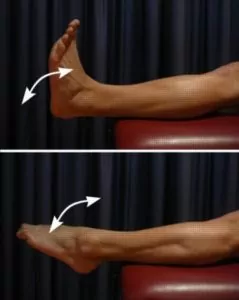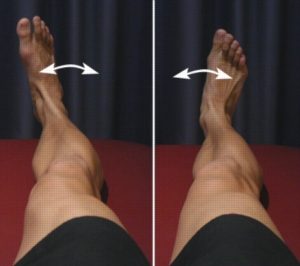Calcaneal Stress Fracture
Updated:
(Also known as Stress Fracture of the Calcaneus)
What is a calcaneal stress fracture?
The calcaneus is the anatomical name given to the heel bone (figure 1). Several muscles attach to the calcaneus so that when they contract, they exert a pulling force on the bone. Furthermore, weight bearing activity places compressive forces through this bone. When these forces are excessive or too repetitive and beyond what the bone can withstand, bony damage can gradually occur. This initially results in a bony stress reaction, however, with continued damage may progress to a calcaneal stress fracture.

Causes of a calcaneal stress fracture
Stress fractures of the calcaneus typically occur over time with excessive weight bearing activity such as marching or running. They often present following a recent increase in activity or change in training conditions.
Signs and symptoms of a calcaneal stress fracture
Patients with this condition typically experience a pain on either the inner or outer aspect of the heel bone that increases with impact activity such as marching, running, jumping or landing. In severe cases, walking may be enough to aggravate symptoms. Other symptoms may include night ache or pain on firmly touching or squeezing the heel bone.
Diagnosis of a calcaneal stress fracture
A thorough subjective and objective examination from a physiotherapist may be sufficient to diagnose a calcaneal stress fracture. Investigations such as an X-ray, MRI, CT scan or bone scan are usually required to confirm diagnosis.
Treatment for a calcaneal stress fracture
Treatment for a stress fracture of the calcaneus typically involves an initial period of rest, usually involving reduced weight bearing activity. This may include the use of crutches or a protective boot. This initial period of reduced weight bearing may occur for approximately 6 weeks. Following this, a gradual increase in weight bearing activity and exercise can usually take place provided symptoms do not increase. This should occur over a period of weeks to months with direction from the treating physiotherapist and will vary depending on the severity of the injury.
Alternative exercises placing minimal weight bearing forces through the affected bone should be performed to maintain fitness such as swimming, cycling, and water running. Exercises to restore flexibility, strength, balance and function should also be performed to ensure the foot and ankle are functioning correctly. The treating physiotherapist can advise which exercises are most appropriate and when they should be commenced.
Contributing factors to the development of a calcaneal stress fracture
Several factors may contribute to the development of a calcaneal stress fracture. These factors need to be assessed and corrected where possible with direction from the treating physiotherapist and may include:
- poor foot posture
- muscle weakness
- poor flexibility
- ankle joint stiffness
- poor footwear
- inappropriate or excessive training (particularly on hard or uneven surfaces).
Physiotherapy for a calcaneal stress fracture
Physiotherapy treatment is vital for all patients with a calcaneal stress fracture to hasten healing, reduce the likelihood of recurrence and ensure an optimal outcome. Treatment may comprise:
- soft tissue massage
- joint mobilization
- electrotherapy (e.g. ultrasound)
- taping
- the use of crutches
- biomechanical correction
- education
- hydrotherapy
- exercises to improve strength, balance and flexibility
- a graduated return to activity program.
Other intervention for a calcaneal stress fracture
Occasionally a review with a podiatrist for possible orthotics may be indicated to ensure an optimal outcome. The treating physiotherapist can advise if this is required.
Exercises for calcaneal stress fracture
The following exercises are commonly prescribed to patients with a stress fracture of the calcaneus. You should discuss the suitability of these exercises with your physiotherapist prior to beginning them. Generally, they should be performed 3 times daily and only provided they do not cause or increase symptoms.
Foot and Ankle Up and Down
Move your foot and ankle up and down as far as possible and comfortable without pain (figure 2). Repeat 10 – 20 times.

Foot and Ankle In and Out
Move your foot and ankle in and out as far as possible and comfortable without pain (figure 3). Repeat 10 – 20 times.

Find a Physio
Find a physiotherapist in your local area who can treat a calcaneal stress fracture.
Physiotherapy products for a calcaneal stress fracture
Some of the most commonly recommended products by physiotherapists for patients with this condition include:
- Crutches.
- Ice Packs and Heat Packs.
- Sports Tape.
- Wobbleboards and Duradiscs for Balance Exercises.
To purchase physiotherapy products for a calcaneal stress fracture click on one of the above links or visit the PhysioAdvisor Shop.
Other Exercises
- View more Ankle Flexibility Exercises.
- View Ankle Strengthening Exercises.
- View Balance Exercises.
More Information
- Read about Correct Footwear for running.
- Read about How to Use Crutches correctly.

Link to this Page
If you would like to link to this article on your website, simply copy the code below and add it to your page:
<a href="https://physioadvisor.com.au/injuries/foot/calcaneal-stress-fracture”>Calcaneal Stress Fracture – PhysioAdvisor.com</a><br/>PhysioAdvisor offers detailed physiotherapy information on a calcaneal stress fracture including: causes, symptoms, diagnosis, treatment, exercises, physiotherapy products and more...
Return to the top of Calcaneal Stress Fracture.
